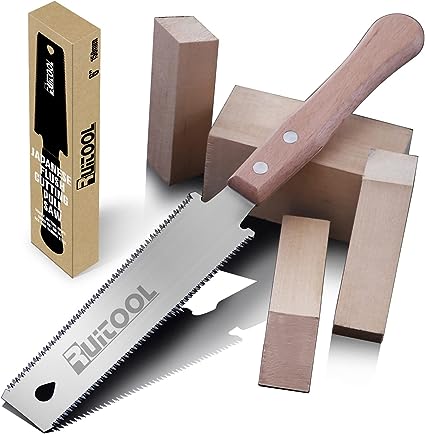Ever feel befuddled by the whole concept of Japanese woodworking tools? I don’t blame you!
Even though you see tools like the Japanese wood saw showered with praise and attention, you can’t shake the feeling that an aura of mystique surrounds these devices. An intimidating feeling for a beginner!
In this post, I’ll try my best to clear up some of the mystery and deliver a rundown of what these tools are, why you should use them, and even give my take on the best choices in 2023!
What Are Japanese Woodworking Tools?
Let’s get to the meat of the issue: What even are Japanese woodworking tools?
In plain English, these are just a type of woodworking tool suited for the Japanese style of woodworking. In Japanese woodworking, you use wood as the sole material (which, you can probably imagine, results in a lot of headaches!)
This style of woodworking calls for its own set of tools to get the job done right.
Why Use Japanese Woodworking Tools?
That still leaves a thorny question: Why would you want to use Japanese woodworking tools? What special pros could they offer over Western instruments?
First, let’s tackle the benefits of these tools, and then we can compare them to their Western counterparts!
What Are the Benefits of Using Japanese Woodworking Tools?
As in many fields (sushi, anyone?), Japan has developed a unique and inventive approach to woodworking.
Compelling advantages of these woodworking tools include:
- Precise work
- An increased dexterity over Western tools
- Simplicity in design
- Connection to the Japanese woodworking philosophy
How Are Japanese Woodworking Tools Different From Western Tools?
When would you want to use Japanese hand tools over familiar Western devices?
Well, there are a couple of reasons:
First, you may want to familiarize yourself with the woodworking style of a different and rich culture.
Or, imagine you’re working on a project that requires a high level of precision that Western tools can’t offer. In that scenario, the Japanese tools are practically built specifically for you, like a personal sidekick!
Types of Japanese Woodworking Tools and Their Uses
Sure, we’ve got the broad strokes of Japanese woodworking tools worked out, but what are the specific tools available?
And, just as crucially, when should you use one over another?
Let’s break it down!
| Product Image | Product Name | SimpleWoodWorking Rating | Pros | Cons | Link |
 | Ruitool Japanese Hand Saw | Easiest to Use | – Lightness. – Sharpness. – Ease of use. | – Rougher cuts. – Loose handle | Check Price Here |
 | Kakuri Japanese Hand Plane | Most Affordable | – Low price – Sharpness. – Small size. | – Unwieldy design. – Difficulty of use. | Check Price Here |
 | Hachiemon 3-Piece Wood Chisel Set | Highest Durability | – Extraordinary sturdiness. – High durability – Sharp edges. | – Higher price tag. – Low precision | Check Price Here |
 | Ranshou Japanese Pull Saw | Best for Sharpness | – Super sharp edges – Affordability – Maneuverability | – Uneven cuts – Safety concerns | Check Price Here |
 | Kakuri Japanese Carpenter Hammer | Most Comfortable | – Comfort – Balance. – Dexterity. | – Requires assembly – Needs additional tinkering. | Check Price Here |
What Are the Common Types of Japanese Woodworking Tools?
It’s essential to note that the varied types of Japanese woodworking tools each have their own flavor or personality, making them especially suited for specific tasks.
Here are a few of the most common tools you’ll encounter:
- Japanese wood saw. A simple, sharp, and affordable option, this tool is a no-nonsense worker that gets the job done.
- Japanese hand plane. Intended to smooth out a wooden surface, hand planes are an unassuming but precious player!
- Japanese wood chisels. Precise and wieldy, Japanese chisels are irreplaceable for many woodworking projects.
Product Reviews
We know the general types of Japanese hand tools, but what about specific products? How can you ensure the device you choose will perform well?
Below, I’ll give a basic overview of five of the best woodworking tools, along with their advantages and drawbacks:
Easiest to Use: Ruitool Japanese Hand Saw

Interested in a Japanese wood saw? You’re in luck! The Ruitool hand saw is one of the most competitive options in town.
What makes it special? Well, the six-inch double-edged blade is made of steel, bases itself off a grinding gear design, and uses pull saw teeth.
Pros
- Lightness. This tool is very light, so you can easily wield and apply it to your projects.
- Sharpness. Super sharp edges mean you’re not gonna be fighting against your saw to construct your designs.
- Ease of use. It’s highly intuitive and trivial for even beginners to figure out.
Cons
- Rougher cuts. The Ruitool isn’t meant for extremely precise work, so you’ll get left with cuts that aren’t exact.
- Loose handle. You might notice a wiggly handle, but a little adjustment should solve that problem.
Verdict
As long as you aren’t doing anything that calls for a robotic level of precision, this hand saw is a strong choice, especially for its price.
Most Affordable: Kakuri Japanese Hand Plane

Alright, so what about Japanese hand planes? This Kakuri hand plane gives any challenger a run for its money!
Built out of high-carbon steel (fancy!), this hand plane is pretty small at only 0.25 kilograms and comes with a cheaper price tag.
Pros
- Low price. If you’re operating on a shoestring budget, I think you’ll find a very good friend in this plane.
- Sharpness. Sharp edges make the tool a real fighter in its (competitive, mind you!) field.
- Small size. Want a mini tool that you can easily move and store without a fuss? You’ve got it!
Cons
- Unwieldy design. The plane offers some frustrating resistance when you try to use it, and the headaches can make it not worth the effort.
- Difficulty of use. Beginners are probably gonna struggle getting the hang of this thing; it’s apparently intended for more experienced woodworkers!
Verdict
While this tool is alluring for budget-conscious buyers, its rugged design is not a good fit for beginners.
Highest Durability: Hachiemon 3-Piece Wood Chisel Set

In the realm of Japanese wood chisel sets, this Hachiemon 3-piece set is something of a superstar.
The set features three blades at 9mm, 15mm, and 24mm.
Pros
- Extraordinary sturdiness. These chisels are rock solid and don’t know the meaning of the word flimsy.
- High durability. The Hachiemon set isn’t gonna wear down much from use, so you can expect to get impressive mileage out of the chisels.
- Sharp edges. Don’t let the bulky feeling fool you: The blades are sharp and make quick work of most materials you’ll find!
Cons
- Higher price tag. The added expense will turn off those looking for a cheaper, budget-friendly addition to their toolbox.
- Low precision. This set isn’t really designed for highly exact work, so don’t expect machine-precise cuts.
Verdict
If you’re looking for an incredibly durable and long-lasting set of chisels (and willing to pay a higher price), the Hachiemon 3-piece set is for you!
Best for Sharpness: Ranshou Japanese Pull Saw

Japanese pull saws are another spot where you can struggle, stress, and downright flail about to find the best fit.
But, you can put those worries to rest, because the Ranshou pull saw is on the scene!
An authentically Japanese hand tool, this pull saw weighs in at a small 1.2 oz and shows off a beautiful wooden grip.
Pros
- Super sharp edges. This saw doesn’t ever mess around with slicing and dicing, so be careful!
- Affordability. Compared to other pull saws, the Ranshou displays a refreshingly reasonable price tag.
- Maneuverability. You’ll be able to use this saw for most tricky angles and cuts, which is a big draw for more complex projects.
Cons
- Uneven cuts. Even by hand tool standards, the saw’s messy cuts leave a lot to desire.
- Safety concerns. While the ultra-sharp edges are an advantage, they can also pose serious safety risks for inexperienced woodworkers.
Verdict
Overall, I’d say the Ranshou saw is basically a sharp and quick woodworking tool, but its jagged cuts would, in most cases, make it a bad fit for any precision work.
Most Comfortable: Kakuri Japanese Carpenter Hammer

Finally, let’s enter the (somewhat intimidating) arena of Japanese carpentry tools. And what better introduction than the Kakuri carpenter hammer?
Constructed from carbon steel (which, honestly, sounds like sci-fi tech), this carpenter hammer weighs a hefty 300g, sports a double-faced head, and will serve you extremely well in heavy-duty carpentry projects.
Pros
- Comfort. The hammer’s a pure delight to use, and you won’t find your hand aching or hurting even after prolonged use.
- Balance. There’s an impressive, almost Zen-like balance to this tool.
- Dexterity. You won’t find many other hammers that can compete with this wieldy design!
Cons
- Requires assembly. Apparently some shipments are put together correctly, so you might have to move components around.
- Needs additional tinkering. To get the most out of the hammer, you’ve got to make your own adjustments to the design.
Verdict
Though this carpenter hammer is comfortable and easy to use, you might need to do some irritating assembly after opening the package.
Our Top Pick: Ruitool Japanese Hand Saw
After weighing the pros and cons, I couldn’t help but come away with the impression that the Ruitool Japanese Hand Saw is simply the best Japanese woodworking tool of 2023.
The saw’s immense ease of use, super sharp edges, and lightweight and comfortable design all blend together to make it a woodworker’s dream. It’s also particularly affordable, so you can get all these advantages without breaking the bank.
Conclusion
That wraps up our dive into the fascinating world of Japanese hand tools!
Japanese woodworking tools are always nearby if you ever need an accurate, simple, and maneuverable set of woodworking accessories.
*This post may contain affiliate links. Please see my disclosure to learn more.



